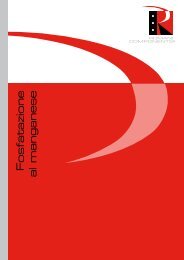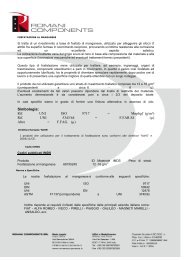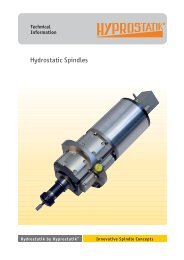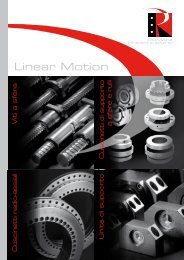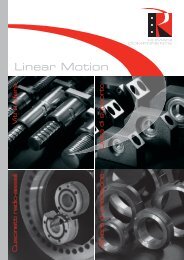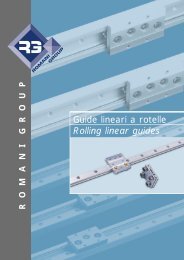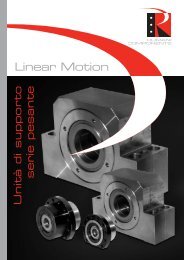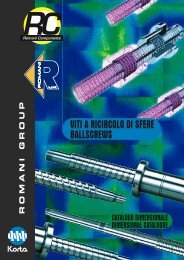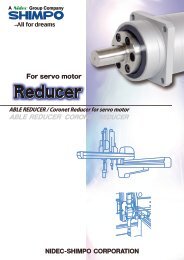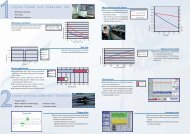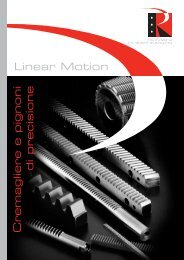catalogo tecnico technical catalogue - Romani Components
catalogo tecnico technical catalogue - Romani Components
catalogo tecnico technical catalogue - Romani Components
You also want an ePaper? Increase the reach of your titles
YUMPU automatically turns print PDFs into web optimized ePapers that Google loves.
8<br />
Condiciones de recepción<br />
Acceptance Conditions<br />
1<br />
Introducción<br />
Introduction<br />
En esta sección se especifican las condiciones<br />
técnicas de recepción y control de los<br />
husillos a bolas incluyendo las tolerancias válidas<br />
para los ensayos de recepción según la<br />
norma DIN 69051/3, relacionada con la norma<br />
ISO 3408/3.<br />
La recepción de husillos a bolas se realiza<br />
teniendo en cuenta las clases de tolerancia<br />
básicas según ISO 286/2:1988. Las desviaciones<br />
límites de cada ensayo se desglosan en las<br />
cinco clases de tolerancias básicas IT (ver tabla<br />
5).<br />
The object of this section is to specify the<br />
ball screw control and acceptance conditions,<br />
including admissible errors, for acceptance<br />
tests according to DIN 69051/3 which is related<br />
to the ISO 3408/3 standard.<br />
For the acceptance of ball screws, the<br />
basic tolerance grades defined in ISO<br />
286/2:1988 are borne in mind. The maximum<br />
permissible deviations for each test are classified<br />
in the five basic IT tolerance grades (see<br />
table 5).<br />
2<br />
Conceptos<br />
Concepts<br />
Los siguientes conceptos están dados<br />
según la norma DIN 69051/1, relacionado con la<br />
norma ISO 3408/1.<br />
l 0 = Recorrido nominal. Es el recorrido<br />
que se obtiene al girar la tuerca respecto al<br />
husillo, partiendo del paso nominal (ver página<br />
15) multiplicado por el número de revoluciones.<br />
l s = Recorrido teórico. Es el recorrido<br />
axial que se obtiene al girar la tuerca respecto<br />
al husillo, partiendo del paso teórico (ver página<br />
15) multiplicado por el número de revoluciones.<br />
l a = Recorrido real. Es el recorrido axial<br />
efectivo de una tuerca sobre un husillo o viceversa,<br />
después de un determinado número de<br />
vueltas.<br />
l u = Recorrido útil. Es el recorrido más la<br />
longitud de tuerca a bolas.<br />
l m = Recorrido real medio. Es el recorrido<br />
real promediado a lo largo del recorrido útil.<br />
l e = Sobre recorrido. Es el recorrido axial<br />
que se encuentra fuera del recorrido útil y que<br />
sirve de seguridad.<br />
c = Compensación del recorrido . Es la<br />
diferencia acordada entre el recorrido teórico y<br />
el nominal a lo largo del recorrido útil.<br />
The definitions of the following concepts<br />
are defined according to the DIN 69051/1 standard<br />
that refers to ISO 3408/1.<br />
l 0 = Nominal travel. This is the travel<br />
resulting from the rotation of the nut about the<br />
screw shaft and which is calculated by multiplying<br />
the nominal lead (see page 15) by the<br />
number of revolutions.<br />
l s = Specified travel. This is the axial<br />
displacement resulting from the rotation of the<br />
nut about the screw shaft, which is calculated<br />
by multiplying the specified lead (see page 15)<br />
by the number of revolutions.<br />
l a = Actual travel. This is the actual displacement<br />
of the ball nut relative to the ball<br />
screw shaft, or vice versa, for a given number<br />
of revolutions.<br />
l u = Useful travel. It is equal to the<br />
length of stroke plus the ball nut body length.<br />
l m = Actual mean travel. This is the<br />
averaged actual travel along the useful travel.<br />
l e = Excess travel. This is the axial displacement<br />
beyond the useful travel, which is<br />
provided for safety purposes.<br />
c = Travel compensation, the agreed<br />
difference between the specified travel and the<br />
nominal travel within the useful travel.<br />
21



